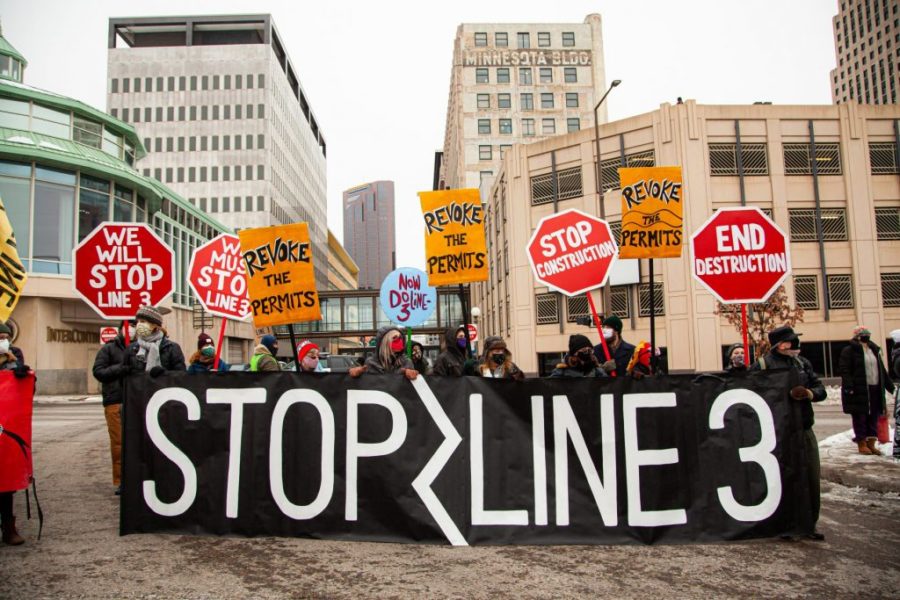“Stop Line 3” for the environment and Indigenous rights
Protesters campaigning to stop Line 3, a tar pipeline currently under construction in northern Minnesota threatening over 200 bodies of water, as well as Native American territory.
September 10, 2021
Policies involving the oil industry have long been subject to heated debate in the United States. Line 3—a crude oil pipeline built by Enbridge Inc., Canada’s largest oil company—is now posing danger not only to a rapidly warming climate, but also to Indigenous communities.
Built in the 1960s, Line 3 currently extends from the tar sands of Alberta, Canada to Superior, Wisconsin. Citing the pipeline’s old age and consequent deterioration, Enbridge proposed an expansion in both length and width in 2014, intending to double the oil transported to nearly a million barrels per day. According to the Enbridge website, “replacing an aging pipeline with new, modern construction is the safest and best option for protecting the environment.”
However, Enbridge’s obscene safety record, even when compared to other major pipeline companies, suggests quite the contrary. The company was called out by the National Transportation Safety Board for its role in the 800,000 gallon spill in Michigan’s Kalamazoo River in 2010, as well as 800 spills in the U.S. and Canada between 1999 and 2010, leaking a total of 6.8 million gallons of oil. Moreover, the proposed project would affect wetlands and the treaty territory of the Anishinaabe people. Several Enbridge employees have already been arrested due to violence against Indigenous women during the building of these pipelines, revealing Enbridge Inc.’s implication in an increase in sex trafficking and sexual violence in Native American communities.
The reconstruction of Line 3 gives rise to major concerns. In the event that the pipeline bursts (noting Enbridge’s intention to double the pipe’s current carrying capacity to 790,000 barrels per day), the pipeline will threaten Minnesota waters. The proposed new pipeline corridor runs through the Mississippi headwaters and Minnesota’s lake country, jeopardizing the state’s $12.5 billion tourism economy. It has faced consistent opposition from farmers, given its passage through farmland and closeness to several organic farms. Additionally, the route crosses remote wetlands which would be inaccessible to emergency cleanup equipment in the event of a spill, meaning that the company will have to create new roads.
More specific concerns arise regarding the effects of Line 3’s “replacement” and the handling of the abandoned pipeline. The company stated that “The Project route, facility design, and construction procedures have been designed to minimize impacts on the environment.” However, the Department of Commerce “found no need for the project and recommended not permitting the project.” Under the plan, the old Line 3 would be filled with nitrogen and sealed, potentially endangering future landowners. If an underground pipeline in the water table were to crack, the surrounding water would pour in, potentially draining a wetland or river and depriving residents of access to the water. Similar risks await when the “new” Line 3 eventually ages and becomes obsolete.
Finally, in the big picture, Line 3 is about the expansion of the tar sands industry. Line 3’s contribution to the ongoing climate crisis would surpass that of Minnesota’s entire economy, a jarring fact considering that the United States became a net exporter of refined petroleum products in 2011. In light of the current overabundance of oil and our society’s gradual transition to a cleaner economy, Citizens Acting for Rail Safety has called new oil pipeline construction “short sighted.” Moreover, Line 3 would violate the treaty rights of the Anishinaabe people and other Indigenous peoples in its path.
With yet another climate battlefield to traverse, youths—the majority of the college student population—will now bear an even greater responsibility to fix a system they did not create. Awareness about Line 3 is therefore important to students on the Case Western Reserve University campus, considering its effects on not only global warming but also Native American communities. Students interested in advocating for the issue can find more information at https://www.stopline3.org/#intro.



